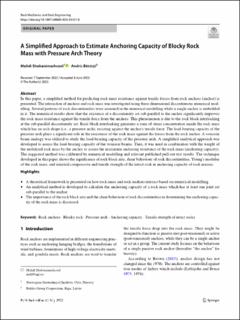A Simplified Approach to Estimate Anchoring Capacity of Blocky Rock Mass with Pressure Arch Theory
Peer reviewed, Journal article
Published version
Permanent lenke
https://hdl.handle.net/11250/3105294Utgivelsesdato
2023Metadata
Vis full innførselSamlinger
- NGI articles [1026]
Sammendrag
In this paper, a simplified method for predicting rock mass resistance against tensile forces from rock anchors (anchor) is presented. The interaction of anchors and rock mass was investigated using three-dimensional discontinuous numerical modelling. Several patterns of rock discontinuities were assumed in the numerical modelling while a single anchor is embedded in it. The numerical results show that the existence of a discontinuity set sub-parallel to the anchor significantly improves the rock mass resistance against the tensile force from the anchors. This phenomenon is due to the rock block interlocking at the sub-parallel discontinuity set. Rock block interlocking generates a zone of stress concentration inside the rock mass which has an arch shape (i.e., a pressure arch), resisting against the anchor's tensile force. The load-bearing capacity of the pressure arch plays a significant role in the resistance of the rock mass against the forces from the rock anchor. A voussoir beam analogy was utilised to study the load-bearing capacity of the pressure arch. A simplified analytical approach was developed to assess the load-bearing capacity of the voussoir beams. Then, it was used in combination with the weight of the mobilised rock mass by the anchor to assess the maximum anchoring resistance of the rock mass (anchoring capacity). The suggested method was calibrated by numerical modelling and relevant published pull-out test results. The technique developed in this paper shows the significance of rock block size, shear behaviour of rock discontinuities, Young's modulus of the rock mass, and uniaxial compressive and tensile strength of the intact rock in anchoring capacity of rock masses.
